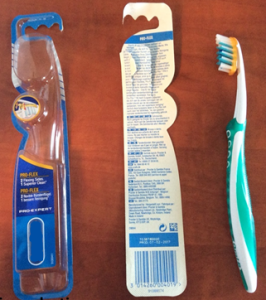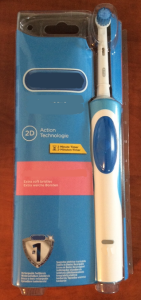Toothbrush inventory
The life cycle taken into consideration comprises the following stages:
extraction of raw materials;
manufacturing;
transport from factory to point of sale;
use in France;
end of life.
Customer transport at the time of purchase was not considered.
Two toothbrushes were dismantled to identify their components. It was also possible to determine their materials and production processes. Life cycle data (transport distance) was also calculated.
Each of these elements must be precisely detailed during the study.
Manual toothbrush
The manual toothbrush consists of a body and packaging.
The toothbrush is made in Ireland. It is transported to France by boat over 740km. Once unloaded, a lorry delivers it to its point-of-sale 400km away.
After 3 months, the user throws it away and it becomes household waste.
Component | Mass | Materials/process | Comment |
Body | 15 g | Polypropylene (PP)/plastic injection moulding | |
4 g | Rubber / plastic injection | corresponds to the grip on the handle | |
2 g | Nylon | corresponds to the bristles on the brush head | |
Packaging | 4 g | Polyethylene terephthalate (PET) / thermoforming | corresponds to the blister pack |
2 g | Rigid cardboard |
Electric toothbrush
The electric toothbrush consists of a body, a motor and a battery. It also includes the charger, brush head and packaging.
Component | Mass | Materials/process | Comment |
Body | 38 g | Polypropylene (PP)/plastic injection moulding | |
7 g | Silicone/plastic injection | correspond to the grip | |
3 g | Steel | corresponds to the internal mechanism | |
Motor | 9 g | Copper | |
9 g | Steel | ||
Battery | 20 g | BatteryNiMH | |
3 g | Electronic components | ||
Charger | 11 g | copper | corresponds to the cable |
27 g | PVC | corresponds to the cable | |
15 g | Polypropylene (PP)/plastic injection moulding | ||
40 g | Rubber | ||
10 g | Electronic components | ||
Tête de brosse | 1 g | Nylon | corresponds to the bristles on the brush head |
2 g | Steel | ||
3 g | Polypropylene (PP)/plastic injection moulding | ||
Packaging | 35 g | Polyethylene terephthalate (PET) / thermoforming | |
33 g | Cardboard | ||
25 g | Printed paper | corresponds to the notice |
The electric toothbrush is made in Germany. It is transported to France by lorry over a distance of 900km. The life of the toothbrush is limited by the life of the battery. This has been estimated at 8 years.
After 3 months, the user throws away the brush head, which undergoes a household waste scenario.
Use
After tests, it was measured that a full charge lasts 15 hours and allows 14 brushings. The charger's power consumption is 0.6W when charging and 0.2W on standby.
It was assumed that it would remain plugged in all the time (even when not charging).
Consumption for a week's use is therefore 39.6 Wh (0.6W*15hours +0.2W*(24*7-15)).

